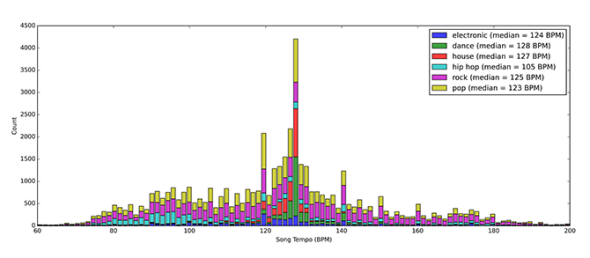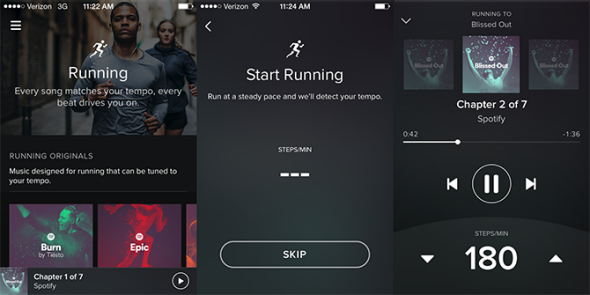It’s a cool summer evening, and I’m striding along the Hudson River in New York’s West Village, testing whether Spotify and I can keep pace with each other. At the end of May, the popular streaming-music service unveiled Spotify Running, promising to deliver “a non-stop mix of music you love—all perfectly in time with your run.” Running is one of several new updates to Spotify’s streaming app, which has also added podcasts, video clips, and more human-curated playlists in recent weeks—features presumably designed to keep Spotify ahead of the competition. With big-name pop stars like Taylor Swift fleeing Spotify, and Jay Z and Apple making their own forays into the streaming business, Spotify has its work cut out for it. So for its latest app enhancement, the company has begun targeting the vast cult of runners. Which is to say, people like me.
I’ve queued up a track called “Blissed Out,” one of six originals Spotify commissioned for Running’s debut. Already, listening to it cuts against my better judgment, partly because “Blissed Out” is built around cheesy, four-chord riffs and synth bursts, but mostly because I object to the idea of being a blissed-out runner. After finding several of Spotify’s other running originals either too mellow or too intense, though, I’ve settled on “Blissed Out” as the Goldilocks option. A pulsating, relentlessly optimistic score—the kind of thing that might soundtrack a Kickstarter appeal or rom-com trailer—floods my headphones. Bliss me out, Spotify.
For runners who like a soundtrack—and I’m usually not one of them—finding the right music is a twofold challenge. First, you need to curate a playlist of sufficiently upbeat, exercise-inspiring songs. Second—and this is the trickier bit—you want the tempo of those tracks to align with the rate at which your feet strike the ground, or what’s known as your running cadence. In theory, any individual should be able to design a digital-music playlist that meets both of these conditions by sorting her library according to beats per minute, and compiling songs that fall in the correct range. Unfortunately, the BPM metadata on music files is notoriously spotty, so doing that successfully usually requires downloading a third-party program that can run the initial analysis. Perhaps more problematically, the popular songs that people like to listen to while working out tend to have tempos that are much slower than ones they should be running at.
“The bulk of the music is like 140 beats per minute, and then you get huge spikes at 120, which is a kind of canonical cadence,” says Nicholas Arcolano, senior data scientist at fitness-tracking app RunKeeper. Compare that to the median runner among RunKeeper’s millions of users, who takes 152 to 155 steps per minute, or to the 170 to 180 beats per minute trainers recommend running at to lower impact and reduce injury. (Elite runners typically pace around 180.) “A lot of electronic dance music is by definition 128 BPM,” Arcolano explains. “Most rock and pop songs are in the 120 to 130 range. You get another spike at like 140, and then it tapers off quickly. When you get up to proper running cadences, it starts to really trail off.”

Courtesy RunKeeper. Data from about 50,000 songs. Click to enlarge.
Most runners would surely prefer the beat of their exercise music to thrust them forward than to hamper their stride. With its new running feature, Spotify has come up with two different ways to do just that. First, the company has combed through its massive repository of songs to build genre-specific playlists at a variety of BPM rates. “Start running to detect tempo,” a woman’s voice instructs when you choose a playlist; as you begin moving, Spotify pinpoints your pace using your smartphone’s accelerometer and gyroscope. Set out at 165 steps per minute with the “Hip Hop & RnB” channel and you might get 50 Cent’s “Piggy Bank” or Jay Z’s “Made in America.” On the “Throwback Hits” selection at 175, you’ll find Don Henley’s “The Boys of Summer” and Weezer’s “Beverly Hills.” (Yes, the Weezer song is kind of slow, but its BPM rate is proportionate to the speed of everything else on the playlist, so as not to disrupt your pace.) The playlists were curated by Spotify’s editorial team and are open to all users of the service, although those with free accounts will hear ads. They’ll also hit a limit after trying to skip too many tracks.
While these playlists succeed at matching the tempo of the music to the cadence of your footsteps—Spotify has even tweaked the transitions between songs so that the beat never wavers—the genres themselves are broad, and the curated lists don’t necessarily include music you actually want to hear. When I tried the “Upbeat Run” selection at 180 BPM, for example, I was served Hilary Duff’s breathy, chintzy “I Am,” which I can only hope was a momentary lapse in Spotify’s algorithmic judgment.
That’s why the second thing Spotify has done for its running feature—commission the six “running originals”—is much more interesting, and potentially far more effective. These tracks are designed to be played and run to at just about any tempo, although once they start, the speed doesn’t adjust. The headliner is “Burn,” a nine-part work composed by Dutch dance music heavyweight Tiësto; the rest were created by “some of the world’s top composers and DJs,” Spotify says, declining to be more specific. This is a big deal for Spotify, which hasn’t previously ventured into original content. (Nike, for its part, got into the business of producing running exclusives about a decade ago, commissioning tracks by Aesop Rock, LCD Soundsystem, and others.) Spotify clearly hopes these originals take off, and is pushing them hard—even free users can listen in without ads.

Screenshots from Spotify Running.
“We started working with a few different artists and creators to think about what music would sound like if it were purposefully built for running,” says Charlie Hellman, vice president of product at Spotify. “What came out were these really sort of fixed, unique, cinematic, emotional journeys.”
Cinematic is dead-on. Running to “The Chase” incites the vaguely stressful sensation of having stumbled onto the set of Inception. The opening of “Epic” could have escaped from John Powell’s Bourne Identity score, while at several points “Blissed Out” sounds like it was scraped from the triumphant guy-gets-girl climax of a romantic comedy. Like library music—compositions made to be licensed to films, TV shows, and commercials—Spotify’s original songs are emotionally generic. This is utility music, meant only to inspire and propel.
That said, on the technical level, Spotify’s originals deploy a few interesting tricks. As a friend who studies music theory explained to me, the catchy IV–I–vi–V riff in “Blissed Out” is “better for running” because the chords are “arranged in such a way that they create as much suspense as possible.” The strongest harmonies essentially fall off the beat, while the weaker ones land on it. “Safe and Sound,” a hit from the synthpop-inspired rock band Capital Cities, features the same chord progression, though their song’s plodding tempo gives it less rhythmic oomph than Spotify’s version. “Blissed Out” is also underscored by pulsating sixteenth notes, which help to drive its momentum. Several miles into my run, my footsteps are still beating in time to “Blissed Out,” even if it hasn’t quite transformed the busy Hudson River Greenway into a runner’s Xanadu.
Spotify began testing its running feature with users back in October, and continued trials in Stockholm and London in the months leading up to launch. The reaction was “really amazing,” Hellman says. “People said it felt like dancing,” he explains. The company did some work with Adidas that it says showed runners listening to music went 15 to 20 percent further. Other research supports this, finding that music both improves mood during exercise and increases endurance by acting as a metronome for energy exertion. As a study published in the Journal of Sports Medicine and Physical Fitness in 2012 concluded, “exercise is more efficient when performed synchronously with music than when musical tempo is slightly slower than the rate of cyclical movement.” On the other hand, a RunKeeper analysis of more than 77,000 running trips across nearly 27,000 users from January to April found “no significant correlations” between the tempo of a runner’s music and the cadence, speed, or length of his gait.
When Spotify first introduced Spotify Running for its iPhone app in late May, the tool was only made available to 1 percent of users; as of late last week, all of Spotify’s iOS users have access. “The numbers are looking great,” Hellman says. “Runners who try this are often running again with the same feature.” Contrary to some earlier reports, Spotify’s running feature doesn’t currently adapt to changes in your pace, though you can manually alter the tempo after it’s been detected. Hellman says the product team thought about making it adjust automatically but decided that the first version should focus on playlists and tracks with a steady beat, which he says sports scientists advised was most important.
The decision to keep your Spotify Running tempo static once it’s initially been detected is arguably the most crucial philosophical decision the company has made for the product. After all, a running app that sets a tempo and stays there isn’t accommodating your run—it’s demanding that you keep pace with it. Training-wise, there’s a strong argument to be made for this. As any good coach will tell you, running at the same pace for the entire time is tremendously more efficient than oscillating speeds. Spotify Running’s metronomic adherence to the beat is the musical equivalent of your coach commanding you to stay disciplined in a race.
The irony is that the very thing that makes Spotify Running such a good training partner also starts to take away from the fun—or, shall we say, the bliss. It’s difficult to lose yourself when you’re hyperconscious of cadence; eventually, the thud of each quarter note starts to amplify the jarring lag before your own sneaker hits the ground. This, more than anything, is why I tend to eschew soundtracks in favor of the ambient noise of my surroundings and the solitude of my thoughts. At a certain point, the very fact of tempo becomes stifling—especially a tempo that refuses to budge.
That shouldn’t detract from what Spotify has accomplished with its inaugural running feature, which is for the most part a great improvement over handpicked playlists. Nor is it to say the company won’t one day release a more dynamic running update. Until then, though, I’ll leave the blissed-out running to others. The beat that drives you forward can quickly become the one that holds you back.
